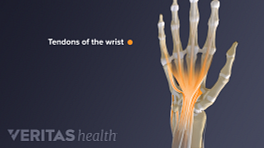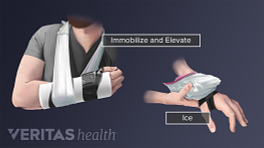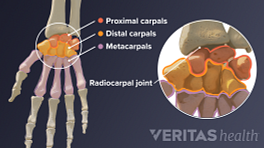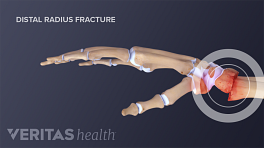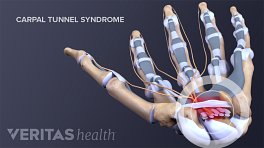Some people have a higher risk of developing wrist tendonitis than others. Some risk factors are lifestyle-related and, therefore, preventable, while others are related to age, diseases, and/or genetics and, therefore, may not be preventable.
In This Article:
- Wrist Tendonitis: An Overview
- Symptoms of Wrist Tendonitis
- Risk Factors and Causes of Wrist Tendonitis
- Diagnosing Wrist Tendonitis
- Treating Wrist Tendonitis Without Surgery
- Surgery for Wrist Tendonitis
Risk Factors for Wrist Tendonitis
Factors that may increase the risk of developing wrist tendonitis include:
- Repetitive movements 1 Mcauliffe JA. Tendon disorders of the hand and wrist. J Hand Surg Am. 2010;35(5):846-53. related to playing sports, house work, and poor workplace ergonomics.
- Age-related changes in the tendon such as stiffness, irregular tissue formation, and up to 50% reduction in the tendon’s ability to bear weight. 2 Eli Carmeli, Hagar Patish, Raymond Coleman; The Aging Hand, The Journals of Gerontology: Series A, Volume 58, Issue 2, 1 February 2003, Pages M146–M152, https://doi.org/10.1093/gerona/58.2.M146.
- Metabolic disorders, such as diabetes, high cholesterol, increased uric acid in the blood (which can lead to gout), and obesity. 3 Michele Abate, Cosima Schiavone, Vincenzo Salini, Isabel Andia; Occurrence of tendon pathologies in metabolic disorders, Rheumatology, Volume 52, Issue 4, 1 April 2013, Pages 599–608, https://doi.org/10.1093/rheumatology/kes395.
- Genetic disorders, such as Ehlers–Danlos syndrome. A common sub-type of this syndrome, the hypermobility type, has a significant association with tendonitis. 4 Gazit Y, Jacob G, Grahame R. Ehlers-Danlos Syndrome-Hypermobility Type: A Much Neglected Multisystemic Disorder. Rambam Maimonides Med J. 2016;7(4).
- Medications, such as non-steroidal anti-inflammatory drugs (NSAIDs) and corticosteroids (both tablets and injections). These medications may reduce the chances of tendon healing and weaken the structure of tendons if taken frequently or for long durations (more than 14 days). 5 Rees JD, Stride M, Scott A Tendons – time to revisit inflammation. Br J Sports Med. 2014;48:1553-1557. , 6 Oliva F, Via AG, Maffulli N. Physiopathology of intratendinous calcific deposition. BMC Med. 2012;10 95-7015-10-95. , 7 Skjong CC, Meininger AK, Ho SS. Tendinopathy treatment: where is the evidence?. Clin Sports Med. 2012;31(2):329-50.
People with one or more of the above risk factors are advised to seek medical attention if they suspect wrist tendonitis or tendinosis.
Causes of Wrist Tendonitis
Wrist tendonitis may be caused by either an:
- Acute injury 8 Bass E. Tendinopathy: why the difference between tendinitis and tendinosis matters. Int J Ther Massage Bodywork. 2012;5(1):14-7. from falls, motor vehicle accidents, playing sports, and non-penetrating blunt injury may cause wrist tendonitis. In severe cases, the tendon may also tear. Acute tendon injury may cause pain, swelling, and stiffness in the tendon. Sometimes, a tendon injury does not cause symptoms initially, but over time the injury can worsen, and tendonitis symptoms may develop. 9 Bishai SK, Plancher KD. !e basic science of lateral epicondylosis: Update for the future. Tech Orthop. 2006;21:250–255.
- Repetitive injury 1 Mcauliffe JA. Tendon disorders of the hand and wrist. J Hand Surg Am. 2010;35(5):846-53. from playing sports or doing other activities may also cause wrist tendonitis. Repetitive injury may cause pain and stiffness in the tendon. The symptoms usually develop over a period of time and may worsen as the injury progresses.
Wrist ligament and tendon problems can have similar symptoms, as well as similar causes and risk factors. In order to get a correct diagnosis and treatment, it is advised to seek medical attention for any painful symptoms in the wrist.
Causes of Wrist Tendinosis
If left untreated, wrist tendonitis may progress to tendinosis—a chronic, non-inflammatory condition where the tendon begins to degenerate. 8 Bass E. Tendinopathy: why the difference between tendinitis and tendinosis matters. Int J Ther Massage Bodywork. 2012;5(1):14-7. Wrist tendinosis can also result from repetitive injury to a wrist’s tendon, such as from work or sports.
See What Is the Difference Between Tendonitis, Tendinosis, and Tendinopathy?
- 1 Mcauliffe JA. Tendon disorders of the hand and wrist. J Hand Surg Am. 2010;35(5):846-53.
- 2 Eli Carmeli, Hagar Patish, Raymond Coleman; The Aging Hand, The Journals of Gerontology: Series A, Volume 58, Issue 2, 1 February 2003, Pages M146–M152, https://doi.org/10.1093/gerona/58.2.M146.
- 3 Michele Abate, Cosima Schiavone, Vincenzo Salini, Isabel Andia; Occurrence of tendon pathologies in metabolic disorders, Rheumatology, Volume 52, Issue 4, 1 April 2013, Pages 599–608, https://doi.org/10.1093/rheumatology/kes395.
- 4 Gazit Y, Jacob G, Grahame R. Ehlers-Danlos Syndrome-Hypermobility Type: A Much Neglected Multisystemic Disorder. Rambam Maimonides Med J. 2016;7(4).
- 5 Rees JD, Stride M, Scott A Tendons – time to revisit inflammation. Br J Sports Med. 2014;48:1553-1557.
- 6 Oliva F, Via AG, Maffulli N. Physiopathology of intratendinous calcific deposition. BMC Med. 2012;10 95-7015-10-95.
- 7 Skjong CC, Meininger AK, Ho SS. Tendinopathy treatment: where is the evidence?. Clin Sports Med. 2012;31(2):329-50.
- 8 Bass E. Tendinopathy: why the difference between tendinitis and tendinosis matters. Int J Ther Massage Bodywork. 2012;5(1):14-7.
- 9 Bishai SK, Plancher KD. !e basic science of lateral epicondylosis: Update for the future. Tech Orthop. 2006;21:250–255.

